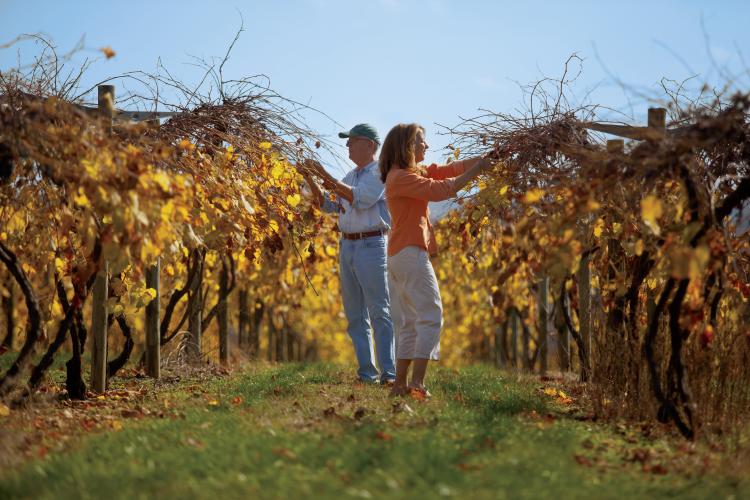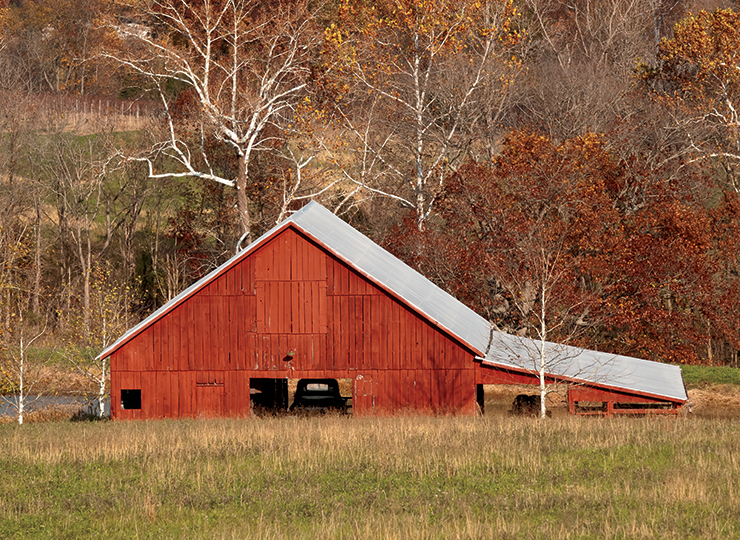Home > Missouri > Missouri Environment > Katy Land Trust Preserves Missouri Farm Country
Katy Land Trust Preserves Missouri Farm Country

To Dan and Connie Burkhardt, nothing quite compares to the beauty and serenity of the Missouri River Valley.
The river bluffs, the forests, the natural areas and the historic family farms create an oasis where Missourians can enjoy the natural beauty, tranquility and serenity of land unspoiled by development. Their love of the land led them to establish the Katy Land Trust to protect the future of Missouri’s 29 million acres of agricultural land.
Through the Trust, producers can get help with guarding their land from development, even after they’re no longer working the land. The Burkhardts’ 220-acre farm has been in production for nearly 20 years in their family, and at least 70 years before that with previous owners. Dan and Connie raise cattle, hay and row crops on the property, in addition to a vineyard on the property’s rolling hillsides. The agricultural tradition is part of their land and will be well into the future.
It will never be a golf course or subdivision. That’s because the Burkhardt’s farm is also the first piece of property in the Katy Land Trust.
“We began the Katy Land Trust as a way to provide an option for people who want to preserve the agricultural use of the land long after they’re gone, through a process called conservation easements,” Dan Burkhardt says. “We had seen how these efforts in other parts of the country were successful in protecting land from development, and we wanted to bring that idea to Missouri. After all, the land cannot protect itself. It depends on the goodwill of its owner to protect it.”

One of the key tools for preserving agricultural land is a conservation easement, a permanent restriction protecting the land from being developed, no matter where the land is sold or inherited. When landowners near the Katy Trail make that commitment, they can be certain that their property will carry on Missouri’s history of focusing on environmental stewardship and agricultural production.
“It provides a way for landowners to guarantee that their properties will be part of the agricultural tradition for generations to come,” says Preston Lacy, program coordinator for the Katy Land Trust.
The Katy Land Trust is not only protecting land in Missouri, it’s also facilitating conversations about conservation among producers that may not otherwise happen and supporting other organizations in similar efforts. “This is a relatively new discussion in Missouri,” Burkhardt says. “But it’s an especially important one.”
Easements and trusts may seem very complicated and sometimes intimidating to producers. The Katy Land Trust staff reach out to farmers and ranchers to begin that discussion and clear up misconceptions about the terms. They do so through a variety of events that provide a forum to get people thinking and talking.
Though the Katy Land Trust is only two years old, it benefits from the efforts of more than 1,700 land trusts that are working to do the same thing across the country. In fact, the Katy Land Trust is a project within the Ozark Regional Land Trust, which began in 1984 and has been responsible for protecting more than 25,000 acres of land in the Ozark region of the United States. The details, including the legal and financial implications of using conservation easements to prevent development on agricultural land, are one of the key areas those organizations work to ensure producers to understand.
One such detail is the stewardship cost, which Lacy describes as the cost of making sure that the landowner’s decision is to protect the property is enforced long after that landowner is gone. That’s another responsibility the Katy Land Trust takes on.
“Generally speaking, it costs $75 to $100 an acre in administrative costs to protect the property,” Burkhardt says. But the Trust has donors who are willing to offset those costs for landowners who do not have the means to pay them. It’s one more way the Katy Land Trust keeps the conservation conversation going.
“There are lots of spokesmen for commercial development,” Burkhardt says. “We’re spokesmen for conservation. People will have many opportunities to develop their land but only one chance to protect it.”



